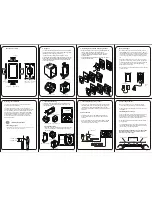
9
For drain back systems, the solar loop often operates at less than 25 psi, far lower than open or closed
loop systems. These low operating pressures do not require an expansion tank. A pressure relief valve,
installed on the drain back tank and piped in copper to an appropriate drainage location, will provide
sufficient expansion protection. This pressure relief valve and drain outlet pipe must never be sealed or
blocked. The pressure relief valve is intended to be operated for safety purposes only.
NOTE:
Supply and return connections to the collector must use eccentric fittings or a fitting arrangement
that allows full draining of header pipes. The collector or array can be mounted level or with up to ¼” pitch
towards the return port to facilitate the drain back process. In addition, Collector plumbing should slope
toward the drain back reservoir at ¼” per foot minimum to facilitate the drain back process. If continual
slope is not achievable, consider a pressurized closed loop system.
E. FLUID QUALITY
Water quality is very important. Water in direct flow through the solar collectors must first meet potable
water requirements; any fluid circulated through the collectors should be non-corrosive to copper. In
addition, water quality must meet the following:
TOTAL DISSOLVED SOLIDS
< 600 ppm
TOTAL HARDNESS
< 200 ppm ÷ 17.1 = 11.7 grains
CHLORIDE
< 40 ppm
FREE CHLORINE
< 5 ppm
MAGNESIUM
< 10 ppm
Table 1
In areas with “hard” water (water hardness greater than 200 ppm) where open loop format is used, lime
scale may form inside the solar collector. Scale deposits will reduce collector efficiency and eventually
plug the collectors. In such regions, it is advisable to install a water softening device to ensure the long
term efficient operation of the collector, or consider a closed loop system.
In order to meet health and safety regulations, glycol used should be food grade propylene glycol, FDA
rated as “generally recognized as safe” (GRAS). If using a glycol/water mix, distilled water is preferred. If
distilled water is unavailable, the water must meet the above requirements. The glycol content of the
liquid must not exceed 50%, unless the manufacturer specifies that a different ratio is recommended for
use with solar water heaters. Glycol should be checked periodically to prevent it from becoming acidic.
Please refer to guidelines provided by the glycol manufacturer regarding glycol maintenance.
F. CORROSION
Both copper and stainless steel are susceptible to corrosion when, amongst other factors, high
concentrations of chlorine are present. The solar collector may be used for heating of spa or pool water,
but levels of free chlorine must not exceed 5 ppm. Otherwise, the copper header could corrode.
NOTE:
HTP DOES NOT WARRANT THE SOLAR COLLECTOR AGAINST CORROSION-RELATED
DAMAGE.
G. FREEZE PROTECTION
Freeze protection must be implemented in any regions that may experience freezing conditions at any
time throughout the year.
“Freeze tolerance limits are based upon an assumed set of environmental conditions. Extended periods
of cold weather, including ambient air temperatures below the specified limit, may cause freezing in
exposed parts of the system. It is the owner’s responsibility to keep the system’s freeze protection levels
Summary of Contents for FP-26SC
Page 32: ...32 MAINTENANCE NOTES ...










































